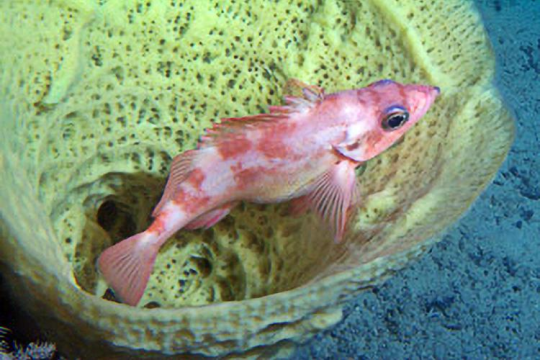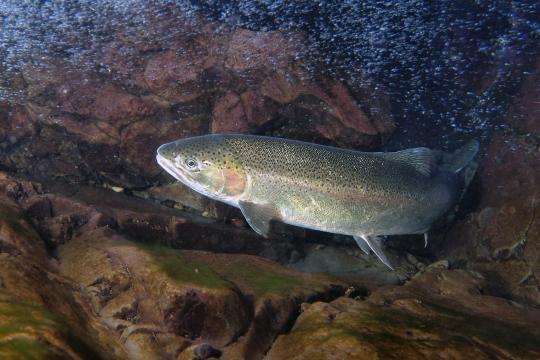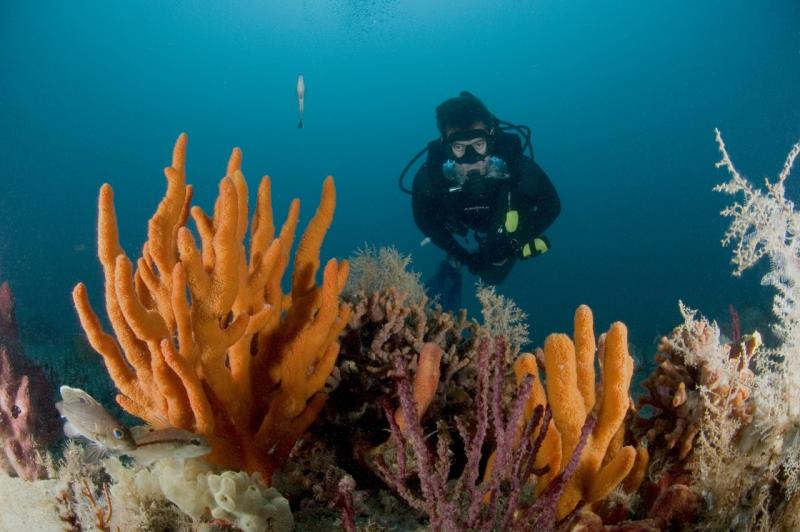Consultations
Consultations
NOAA Fisheries partners with federal agencies and federally recognized tribes to advise and collaborate on activities that might impact endangered and threatened species, marine mammals, and important marine habitats.
This work includes:
-
Consulting with federal agencies whose work might affect important fish habitats that are necessary for the spawning, breeding, feeding, and/or growth of healthy fish populations, and working to mitigate impacts.
-
Collaborating with federal agencies and tribes to address threats to endangered and threatened species that might result from federal programs and actions, including adverse impacts to species’ habitats.
-
Working with tribal governments on marine mammal issues (e.g., whales and seals).
-
Working with federal agencies and tribal governments on the development of fishery management plans.
-
Working with federal agencies and tribal governments on scientific research permits.
Featured News
 NOAA Fisheries, in collaboration with Blue Ocean Mariculture, is conducting a multi-year pilot study to evaluate observational methods and tools for studying Hawaiian monk seal behavior. Courtesy of Blue Ocean Mariculture
NOAA Fisheries, in collaboration with Blue Ocean Mariculture, is conducting a multi-year pilot study to evaluate observational methods and tools for studying Hawaiian monk seal behavior. Courtesy of Blue Ocean Mariculture
AI Meets Aquaculture to Study Hawaiian Monk Seal Interactions With Net Pens
 A pregnant sharpchin rockfish shelters within a sponge on the seafloor off Alaska. Credit: NOAA Fisheries.
A pregnant sharpchin rockfish shelters within a sponge on the seafloor off Alaska. Credit: NOAA Fisheries.

More than 570 federally recognized tribal nations in United States
The United States government recognizes tribal nations as "sovereign domestic dependent nations." Approximately 229 tribes are located in Alaska; the remaining are located in 33 other states.
1,000+ species with identified essential fish habitat
Essential fish habitat has been described for approximately 1,000 managed species. The Magnuson-Stevens Act requires us to identify essential fish habitat and consult with other federal agencies when their actions might adversely affect EFH, so as to conserve such habitat.
Essential Fish Habitat
Healthy habitat is necessary for fish to complete their life cycle, thus contributing to a fishery that can be harvested sustainably. The Magnuson-Stevens Act (Section 305) requires us to identify essential fish habitat for federally managed fish species. We consult with other federal agencies on conservation measures for any actions they fund or authorize that might adversely affect essential fish habitat.
Endangered Species Act Consultations
Under the Endangered Species Act, federal agencies must consult with us when any project or action they take might affect an ESA-listed marine species or designated critical habitat. We assist federal agencies that are required to develop conservation programs for endangered and threatened marine species.
Tribal Consultations
We consult with tribes and Alaska Native corporations about federal actions that might affect tribal governments and their members. We partner with tribal governments in the development of policies, regulations, and programs that impact ESA-listed species and essential fish habitat. We also work with tribes and regional fisheries management councils during the development of fishery conservation and management actions.
For Federal Agencies: How to Initiate ESA Consultations
We strongly encourage federal agencies to contact us well in advance of proposed projects or actions that might affect ESA-listed marine species or designated critical habitat. We provide information, resources, and other materials to facilitate the consultation process.
Tracking Consultations
NOAA Fisheries' Environmental Consultation Organizer (ECO) Public Portal provides information on the status of consultations under Section 7 of the Endangered Species Act and essential fish habitat of the Magnuson-Stevens Act. Users outside of NOAA first need to register for an account before logging in to ECO.
Understanding Consultations with Federal Agencies
Learn how NOAA Fisheries conducts consultations with federal agencies to protect endangered and threatened species and important fish habitat.

Habitat Consultations
When fish and their habitats interact with human-caused activities, we start conversations about how to solve such conflicts. These consultations involve experts getting together to figure out how to achieve the best outcome for all parties involved. Working with federal, state, and local officials, we engage in national-level consultations about fishing activities and non-fishing activities (e.g., power plants, ports, fill, and pollutants). With a clear understanding of how human activities might affect fish and other species navigating their habitat, we can strike a balance between the natural and the human-induced environment.
Our main habitat consultations include:
Essential fish habitat under the Magnuson-Stevens Act.
Hydropower relicensing and fish passage under the Federal Power Act.
Activities that result in modification of streams or other water bodies under the Fish and Wildlife Coordination Act.
Magnuson-Stevens Act—Essential Fish Habitat
Section 305 of the Magnuson-Stevens Act requires us to identify and conserve essential fish habitat for federally-managed fish. Federal agencies, including the military and even other NOAA offices, must consult with us on any action that might adversely affect essential fish habitat. When a determination is made that an action might adversely affect essential fish habitat, we identify measures to avoid, reduce, or compensate for adverse impacts to fish habitat.
Learn more about the essential fish habitat
Learn more about essential fish habitat consultations
Federal Power Act and Hydropower Relicensing
The Federal Power Act requires non-federal hydropower owners to obtain a license from the Federal Energy Regulatory Commission. As part of this process, the Act authorizes NOAA Fisheries to require improved fish passage at dams to ensure the safe, timely, and effective upstream and downstream passage of migrating fish. NOAA Fisheries also recommends conditions to the license that will protect or improve habitat and fish populations.
Fish and Wildlife Coordination Act
The Fish and Wildlife Coordination Act gives NOAA an important advisory role to review and comment on proposed federally permitted activities that could affect living marine resources. As amended in 1964, the act requires that all federal agencies consult with NOAA Fisheries, U.S. Fish and Wildlife Service, and state wildlife agencies when proposed actions might result in modification of a natural stream or body of water. Federal agencies must consider how these projects would affect fish and wildlife and provide for improvement of these resources.
The act allows NOAA Fisheries to provide comments to the U.S. Army Corps of Engineers during review of projects under section 404 of the Clean Water Act (concerning the discharge of dredged materials into navigable waters) and section 10 of the Rivers and Harbors Act of 1899 (obstructions in navigable waterways). NOAA Fisheries comments provided under the Fish and Wildlife Coordination Act are intended to reduce environmental impacts to migratory, estuarine, and marine fisheries and their habitats.
Endangered Species Act Consultations
Under Section 7(a)(1) of the Endangered Species Act, federal agencies are directed to implement programs for the conservation of threatened and endangered species. We assist these agencies with the development of conservation programs for marine species, and we work with federal agencies, like the U.S. Army Corps of Engineers and the U.S. Forest Service, on training and opportunities to implement proactive conservation actions that will benefit ESA-listed species and their habitats.
Under Section 7(a)(2) federal agencies must consult with NOAA Fisheries when any project or action they take might affect an ESA-listed marine species or designated critical habitat. The consultation process can vary depending on the complexity of the project or action. Projects/actions that commonly require consultation include:
Dredging
Hydroelectric activities
Large construction activities
Military exercises, testing, and training
Offshore energy activities
Permitting programs
Scientific research
Seismic surveys
How Federal Agencies Initiate an ESA Section 7 Consultation
NOAA Fisheries staff will work with the federal action agency to develop the documentation (e.g., biological assessment) needed to initiate and complete consultation.
We strongly encourage federal agencies to contact us well in advance of proposed projects or actions. Doing so allows all parties to better understand the proposed project/action, gather the information needed to initiate, and complete the consultation in a timely manner.
For actions that are wholly within a specific region, the federal action agency should contact the appropriate NOAA Fisheries Regional Office:
For actions that span two or more regions and/or are national or global in scope, the federal action agency should contact the Office of Protected Resources ESA Interagency Cooperation Division:
- Contact for initiation, policy, or program-related information
- Contact for technical information specific to ESA Section 7 consultations
Consultation Process
The process usually begins as informal consultation. The federal agency proposing the project or action approaches NOAA Fisheries in the early stages of project planning and requests consultation. Discussions between our agencies include which ESA-listed species might occur in the proposed action area and what effect the proposed action might have on those species and/or designated critical habitat.
If we agree that the proposed project or action is not likely to affect any listed species or designated critical habitat, we provide a letter of concurrence and no further consultation is required.
However, if it appears that the agency’s action might affect a listed species or designated critical habitat, that agency prepares a biological assessment to determine the project’s effect on a ESA-listed species or its critical habitat. A biological assessment includes details on potential effects to a species or its designated critical habitat.
When a federal agency determines that its action is likely to adversely affect a listed species and/or its designated critical habitat, the agency is required to submit a request for formal consultation.
Formal consultations must be completed within 135 days of initiation—90 days for consultation plus 45 days for coordination between the agencies, unless an extension is agreed upon by the agencies. Formal consultations result in NOAA Fisheries developing a biological opinion. The intent of a biological opinion is to ensure that the proposed project or action will not reduce the likelihood of survival and recovery of an ESA-listed species. A biological opinion usually also includes conservation recommendations that further the recovery of ESA-listed species. The biological opinion includes reasonable and prudent measures as needed to minimize any harmful effects, and may require monitoring and reporting to ensure that the project or action is implemented as described.
Learn more about biological opinions
Emergency Consultation
The ESA also recognizes the need to respond immediately to emergencies. We expedite consultations during emergencies so federal agencies can complete their critical missions in a timely manner while still providing protections to listed species. Where emergency actions are required that might affect listed species and/or their designated critical habitats, a federal agency may not have the time for the normal consultation procedures under non-emergency conditions. Emergency consultation expedites communication and allows agencies to incorporate endangered/threatened species concerns into their emergency response.
Learn more:
Tribal Engagements and Consultations
NOAA Fisheries strives to build and strengthen our relationships with Indian tribes, Alaska Natives, and Native Hawaiian and Pacific Islanders. We remain committed to fulfilling the federal trust responsibility to federally recognized tribes.
The relationship between the United States government and federally recognized Indian tribes is one of government-to-government. Central to this unique relationship is the trust responsibility of the U.S. government. It is an obligation on the part of the United States to carry out the mandates of federal law while considering the rights and interests of American Indian and Alaska Native tribes and villages.
Understanding each tribe's unique political, historical, and cultural characteristics allows us to better understand tribal government priorities, concerns, and needs. This then helps us be better stewards of our environment. We are committed to developing policies and procedures that improve our relations with federally recognized Indian tribes on a government-to-government basis.
NOAA Fisheries has management responsibilities for issues of importance to tribes. We consult and engage with tribes and Native corporations about federal actions that might affect tribal governments and their members. Executive Order 13175 (PDF, 4 pages) sets the framework for regular and meaningful consultation and engagement with Tribal Nations in the development of policies, legislation, regulations, and other programs.
For additional information, contact NOAA Fisheries Tribal Liaisons, Heather Sagar (heather.sagar@noaa.gov) and Gabrielle Keeler-May, gabrielle.keeler-may@noaa.gov or view NOAA Tribal Resources.
Alaska Region
Alaska Natives have a long history of self-regulation based on the need to ensure a sustainable take of marine mammals for food and handicrafts. In Alaska, we engage and consult with tribes and Native corporations about federal actions that might affect tribal governments and their members. Executive Order 13175 sets the framework for regular and meaningful consultation and collaboration with Alaska Native representatives in the development of policies, legislation, regulations, and programs.
We use best available scientific information, as well as traditional and contemporary Alaska Native knowledge and wisdom, for decisions regarding Alaska marine mammal co-management to the extent allowed by law. Our co-management agreements with Alaska Native organizations encourage full and equal participation by Alaska Natives in decisions affecting the subsistence management of marine mammals, as a tool for conserving marine mammal populations in Alaska. Agreements encourage the exchange of information regarding the conservation, management, and use of marine mammals in U.S. waters in and around Alaska.
Learn more about tribal consultations in Alaska
Contact NOAA Fisheries Alaska Tribal Liaisons:
- Alaska Regional Office: Amilee Wilson, amilee.wilson@noaa.gov
- Alaska Fisheries Science Center: Marjorie Mooney-Seus, marjorie.mooney-seus@noaa.gov
Greater Atlantic Region
In the Greater Atlantic Region, we are strengthening our relationships and partnerships with federally recognized tribes. This will allow us to advance activities to conserve and recover protected species, sustain fisheries and their communities, and protect marine and estuarine habitats. Regular and meaningful consultation and collaboration is guided by the framework established under Executive Order 13175 and NOAA’s Tribal Consultation Handbook (PDF, 4 pages). With knowledge of tribal government processes and cultural practices, we can better understand tribal positions and needs and, together, be better stewards of our environment.
Tribal work includes issues related to:
- Protected species such as Atlantic salmon, marine mammals, and sea turtles
- Ecosystem restoration
- Aquaculture
- Ocean acidification
We have awarded species recovery grants to tribes in this region. The funds support management, outreach, research, and monitoring projects that directly benefit Endangered Species Act-listed species, recently delisted species, species proposed for listing, and candidate species.
Contact NOAA Fisheries Greater Atlantic Tribal Liaisons:
- Greater Atlantic Regional Fisheries Office: Ellen Keane, ellen.keane@noaa.gov
- Northeast Fisheries Science Center: Patricia M. (Trish) Clay, patricia.m.clay@noaa.gov
Southeast Region
The Southeast Region covers nearly 20,000 miles of tidal coastline throughout the South Atlantic, Gulf of America, and Caribbean. This includes:
- Eight coastal states: North Carolina, South Carolina, Georgia, Florida, Alabama, Mississippi, Louisiana, and Texas
- Inland watershed states: Arkansas, Iowa, Kansas, Kentucky, Missouri, Nebraska, New Mexico, Oklahoma, and Tennessee
- Commonwealth of Puerto Rico and the U.S. Virgin Islands
The Southeast Region is working towards building effective and helpful partnerships with federally recognized tribes for advice and collaboration on activities that might impact endangered and threatened species, marine mammals, fisheries, and important marine habitats.
Contact NOAA Fisheries Southeast Tribal Liaisons:
- Southeast Regional Office: Calusa Horn, calusa.horn@noaa.gov
- Southeast Fisheries Science Center: Joy Merino, joy.merino@noaa.gov
West Coast Region
West Coast Region Indian tribes retain strong spiritual and cultural ties to marine and other aquatic resources including salmon and steelhead. They have used these resources for thousands of years for tribal religious/cultural ceremonies, subsistence, and commerce. Many Pacific Northwest Indian tribes have treaties reserving their right to fish in “usual and accustomed” fishing places and include many species.
We recognize the rights of federally recognized Indian tribes to self-government and sovereign power over their members and territories. In the West Coast region, we protect those rights by partnering with Pacific Northwest Indian tribes to address natural and cultural resource issues.
Our work with tribes includes:
- Formation of salmon recovery teams and development of associated implementation plans
- Creation of task forces such as the Columbia Basin Partnership
- Education opportunities such as the Discovery Internship Program with the Northwest Indian College
- Funding opportunities through various grants such as the Pacific Coastal Salmon Recovery Fund
- Provision of resource tools and guides for tribal interaction and government-to-government consultation
Learn more about tribal consultations on the West Coast
Contact NOAA Fisheries West Coast Tribal Liaisons:
- West Coast Regional Office: Lalena Amiotte, lalena.amiotte@noaa.gov and Jhenevieve Cabasal, jhenevieve.cabasal@noaa.gov
- Northwest Fisheries Science Center: Anna Kagley, anna.kagley@noaa.gov and Zayleen Kalalo, zayleen.kalalo@noaa.gov
- Southwest Fisheries Science Center: Nate Mantua nate.mantua@noaa.gov
Pacific Islands
The Pacific Islands Region does not have any federally recognized tribes. However, we recognize the value of working with native Hawaiian groups and others on resource management issues. We partner with many indigenous Pacific Islander groups throughout the region who have an interest in NOAA's activities and want to assist in executing our mission in a culturally responsible manner.
For instance, we engage with native Hawaiian cultural practitioners in marine mammal stranding responses whenever possible. We invite cultural practitioners to participate in helping us become more culturally sensitive about being respectful to individual animals and to the people of the community where these strandings occur. It is our goal to continue to build respectful relationships and responses that expand this effort, while remaining in compliance with the Marine Mammal Protection Act and Endangered Species Act.